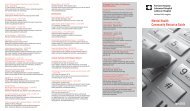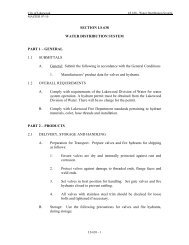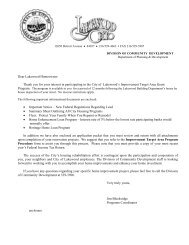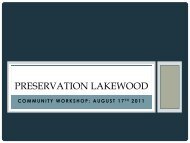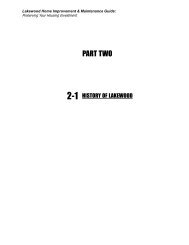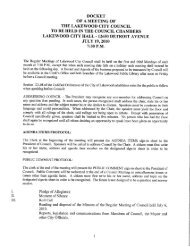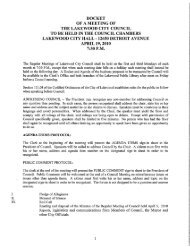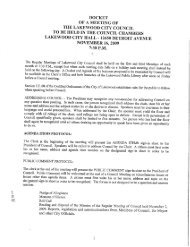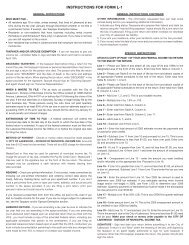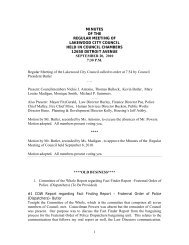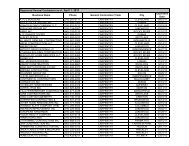1 DVCAC Victim Advocacy Services - LoveLakewood.com
1 DVCAC Victim Advocacy Services - LoveLakewood.com
1 DVCAC Victim Advocacy Services - LoveLakewood.com
You also want an ePaper? Increase the reach of your titles
YUMPU automatically turns print PDFs into web optimized ePapers that Google loves.
7. Project Funding SourcesFunding Source Requested *Committed TotalApplicant Agency Funds 0 33,673 33,673CDBG FY13-14 Carry Forward Funds (Estimated) 0 0 0Other (Non-CDBG) Federal 0 0 0State Government 0 0 0Local Government 0 0 0County Government 0 0 0Private Sector (Foundations, etc…) 0 0 0Revenues (Client Fees/Program In<strong>com</strong>e) 0 0 0Other: Click here to enter text. 0 0 0Other: Click here to enter text. 0 0 0Other: Click here to enter text. 0 0 0Lakewood FY14 CDBG Request $ 6,827 $ 0 $ 6,827Totals $ 6,827 $33,673 $40,500*Please attach a Commitment Letter from all funding sources indicated above for which one is available. If unavailable atthis time, please provide immediately upon issuance.IX.APPLICANT INFORMATION & CAPACITIES1. Briefly describe the agency’s mission, purpose, goals and objectives, including specific qualifications to implementthe proposed project and previous success executing similar programs.The Domestic Violence & Child <strong>Advocacy</strong> Center (<strong>DVCAC</strong>) empowers individuals, educates the <strong>com</strong>munity, andadvocates for justice to end domestic violence and child abuse. <strong>DVCAC</strong> envisions a <strong>com</strong>munity in which all peopleenjoy lives free from violence and abuse and feel safe in secure in their relationships. For over 35 years, <strong>DVCAC</strong> has ledthe <strong>com</strong>munity in responding to victims of child abuse and domestic violence, working to break the cycle of abuse viaprevention, intervention and <strong>com</strong>munity education. The only organization in Cuyahoga County devoted solely to theissue of domestic violence, <strong>DVCAC</strong> provided intervention and prevention services to over 35,000 men, women andchildren in FY 2012.The agency is dedicated to healthy relationships and provides a continuum of services for persons of all ages who havebeen victims of, or are at risk of being victims, of domestic violence, child abuse, or other family or relationshipviolence. <strong>DVCAC</strong>'s service model incorporates best practices and evidenced-based strategies. As a dynamic <strong>com</strong>munityleader, we create solutions and partnerships to address abuse and provide services to those who need them.Moreover, <strong>DVCAC</strong> has engaged in aggressive advocacy on behalf of victims of relationship violence and their childrenfor over twenty-five years. We are deeply <strong>com</strong>mitted to advocacy as a principal strategy to improve the justice system toassure that victims of abuse achieve safety, autonomy, health, well-being, independence, restitution, and justice.<strong>DVCAC</strong>’s approach is grounded in self-determination and operates from a strength-based, empowerment philosophywhile incorporating best practices and evidenced-based strategies. As best-practices have emerged in the field, <strong>DVCAC</strong>has tailored its work accordingly—moving from a shelter-based model to the more <strong>com</strong>prehensive approach of providingleadership to create responsive systems, offering an array of services and programs, and addressing the need for primaryprevention. <strong>DVCAC</strong> is known specifically for the innovation of addressing issues of abuse along the life continuum witha focus on breaking the cycle and has presented its model at many local, regional and national conferences.9
The Justice System <strong>Advocacy</strong> Program provides advocacy and supportive services to victims of domestic violencethroughout the justice system process. Justice System Advocates also facilitate support groups which provide victimswith peer support, feedback, and encouragement. Advocates assist victims in learning about and securing legal rights;locating emergency financial assistance; intervening with employers, creditors and others on behalf of the victim;assisting in filing for losses covered by public and private insurance programs, including workman’s <strong>com</strong>pensation,unemployment benefits, and welfare; and accessing health care.<strong>DVCAC</strong> has provided advocacy services to Cuyahoga County victims of domestic violence for over 20 years…and theywork. Studies show that victims who received legal advocacy services reported decreased abuse at a six week follow up<strong>com</strong>pared to a control group (Bell & Goodman, 2001). <strong>Victim</strong>s receiving advocacy intervention also are also less likelyto have experienced abuse at a two year follow up as <strong>com</strong>pared to a control group (Bybee & Sullivan, 2002). A 2004Ohio Domestic Violence Network study found that advocacy services provided via Justice System Advocates wereextremely effective in helping them protect themselves and their children from further maltreatment with the leastamount of disruption to their daily lives.<strong>DVCAC</strong> also provides <strong>com</strong>munity-based support groups for victims of domestic violence in Cuyahoga County tocounteract the isolation that is often central to the experience of domestic violence victimization. Support groups reduceisolation, offer hope, options and resources, empower victims and increase safety. Support groups are often rated byabused women as a helpful and effective means of coping with abuse (Gondolf & Fisher 1988). These services reduce theneed for emergency shelter, allowing victims to avoid transferring children to new schools, preventing disruption inemployment, and keeping victims in control of their daily lives.Finally, <strong>DVCAC</strong> data demonstrate a sustained demand for these services. JSAP served 1,665 victims countywide with allfunding sources in 2010; 1,743 in 2011; and 1,746 in 2012.2. Do other Lakewood organizations offer the same or substantially similar services? If yes, describe how theproposed program will partner with and/or enhance rather than duplicate these efforts. No3. What is the agency’s geographic service area? Cuyahoga County4. Is the agency itself or its personnel licensed or accredited to perform some or all of the activities described in thisproposal? If yes, by whom?Yes. <strong>DVCAC</strong> is accredited by the Commission on Accreditation of Rehabilitation Facilities (CARF).5. Does the agency have the capacity to serve non-English-speaking persons? If yes, describe. If no, describe eitherplans to develop this capacity or why this capacity is unnecessary.Yes. <strong>DVCAC</strong> employs three staff who are fully bilingual in Spanish and English. These staff are available to assist theLakewood JSAP Advocate and/or directly provide services. <strong>DVCAC</strong> regularly serves victims from a variety ofethnicities and cultures whose first language is not English. The agency employs the services of the Language Line andothers, when an interpreter is needed to assist victims.Domestic Violence & Child <strong>Advocacy</strong> Center employs three staff who are fully bilingual in Spanish and English. Thisstaff is available to assist the Lakewood Advocate and/or directly provide services. Domestic Violence & Child<strong>Advocacy</strong> Center regularly serves victims from a variety of ethnicities whose first language is not English. <strong>DVCAC</strong> alsoutilizes the Language Line, Asia Inc., Catholic Charities and the Jewish Family Service Association (Russian language)when an interpreter is needed for any variety of languages and dialects.10
6. How many total people and Lakewood residents did the agency serve during FY12 (Jan 1 – Dec 31, 2012)?Total People: 39,575Lakewood Residents: 1797. How many low-moderate in<strong>com</strong>e Lakewood residents did the agency serve during FY12? 1648. What percentage of the agency’s total client base is represented by Lakewood residents? .45%9. Indicate the agency’s annual expenses by type in the table below.Expenditure Type Amount % TotalSalaries & Benefits $ 2,377,713 73.89%Operating Costs $ 594,595 18.48%Capital Costs $ 90,000 2.80%Other: Program services and supplies $ 155,500 4.83%Other: Click here to enter text. 0 0Other: Click here to enter text. 0 0Total Annual Budget $3,217,808 100.00%10. List the agency’s primary revenue sources.i. Violence Against Women Act (VAWA)ii. U.S. Department of Housing & Urban Developmentiii. United Way of Greater Clevelandiv. Cuyahoga County Marriage License Feesv. Click here to enter text.11. Explain any significant changes in the agency’s revenue sources over the past two (2) years.Several government grants continue to make cuts every year which then puts more stress on our fundraising. Thecontinual trend we see in shelter is that women and children <strong>com</strong>e in with more injuries, more severe injuries, andmultiple challenges and <strong>com</strong>plexities of cases, which puts a major strain on our program.12. What strategies are being developed to generate new and/or different funding sources?We have launched a major donor campaign which has shown some initial positive results.13. What efficiency and cost effectiveness measures have been implemented over the past two years?Part of our agency’s recent strategic plan is to measure and evaluate all programs on an ongoing basis, including thefactors beyond our control, to assess their effectiveness and impact. In this tight economy, the board made the decision tosuspend the Kinship Care Program and our Parenting Classes as of January 1, 2013 due to the lack of funds to fullysupport these programs and the lack of referrals. <strong>DVCAC</strong> has many programs that are full or have waiting lists, andputting the resources into meeting the demand of our current clients is a better usage of funds.11
14. Describe the tools and methods used to track, evaluate, and document organizational effectiveness including thoseused to track individual patient/client progress.<strong>DVCAC</strong> keeps accurate statistics and records for all services including number of clients, demographic data and types ofservices provided. All data is entered into a <strong>com</strong>prehensive database system (ALICE) which is monitored by the ProgramCoordinator. The ALICE system collects custom statistics regarding JSAP including a breakdown of the individualservices provided by the program.15. Describe the processes and tools used to gauge client/patient/customer satisfaction with the quality of servicesrendered and how results are used to inform and improve the quality of services.Data is collected at point of service via the Ohio Attorney General’s Out<strong>com</strong>es Measure Survey Results Report. Thesesurveys are distributed by Justice System Advocates and tabulated and analyzed by the Program Coordinator. The surveyresults are the focus of the Collaboration Board meetings, which are held quarterly. Results are analyzed and used tomake re<strong>com</strong>mendations and/or modifications to program services.16. Describe outreach efforts to ensure Lakewood residents and potential beneficiaries are aware of programs andservices offered through the CDBG-funded program.Marketing the JSA Program is essential to ensuring that victims are referred to the agency and can take advantage of theprogram and its services. Advocates and volunteers distribute information and materials about domestic violence and<strong>DVCAC</strong> services to law enforcement, courts, social services, hospitals and other institutions in the City of Lakewood.17. In which Fiscal Year was the organization’s most recent single A-133 audit? 2012Were there any findings?No.18. Does your organization maintain the following?Personnel Policy Manual (Yes/No)Affirmative Action Policy (Yes/No)Employee Grievance Procedures (Yes/No)YesYesYes12



